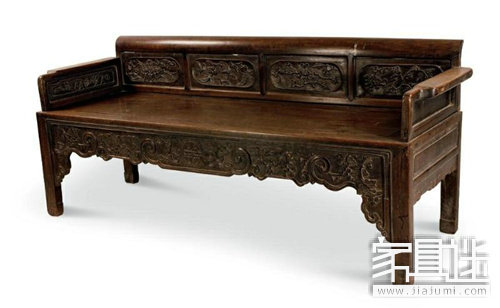Demystifying the makeup of mahogany furniture
Whether the mahogany furniture materials are shoddy, whether the craft is cut or not, and whether it is fine, not only determines the use value of the furniture, but also is the profit-making point for the merchant to reduce the production cost. Recognizing these tricks, you can accurately judge the true value of furniture at the time of purchase, and prevent the use of information asymmetry to spend more money or even be cheated.
Material identification
The same category of rosewood fraud
Several types of mahogany in the same category are difficult for consumers to distinguish because of similar texture, properties, color, and density. In terms of price, the prices of different materials are different, and the production costs are also different. For the purpose of profit-seeking, the merchant will pretend to be a high-priced mahogany with low-priced mahogany.
At present, the most common in the market is the confusion of seven species of red rosewood and other species. Among the seven types of wood, S. chinensis has the highest cost and is the most popular. Made from Central America, Dalbergia sinensis, Bahrain Dalbergia and A. sinensis from Southeast Asian countries are often used as a counterfeit Dalbergia. Consumers should be cautious when buying too cheap. Please ask the merchant to write the scientific name of the wood used. Some parts should be marked with other materials.
Discrimination method: Compared with Dalbergia chinensis, the dimpled Dalbergia is produced in Central America, and the growth wheel is more obvious. The black and yellow lines with clear texture can be seen on the cut surface of the furniture, and the lines are thicker. The new cut surface of the heartwood of Sian rosewood is dark red or purple red, and the dimpled Dalbergia is orange-red, but the color is darker and darker, and the colors are closer.
Merchants also use the same texture of wood to impersonate mahogany materials. For example, ironwood beans pretend to be red rosewood, and Kodiva red sandalwood (commonly known as ketan) is a sandalwood rosewood (commonly known as lobular rosewood). Some merchants will use it in hidden parts such as dental plates and side panels, and bold businesses will use fake materials.
Sapwood shoddy
The dark part of the wood is called "heartwood", while the whitish part that surrounds the heartwood is called "white skin", also called "sapwood". According to the national standard "Redwood", "Redwood" is defined as the heartwood of the genus Pterocarpus, Dalbergia, Diospyros, Yam, and Teppanyaki. Therefore, only wood heartwood can be called "redwood", white skin can not Called "Redwood."
The white skin is easily eroded by insects, which not only affects the aesthetics of the furniture, but also affects the firmness and service life of the furniture. From the perspective of economic costs, the price of heartwood is dozens of times that of white skin. According to the national light industry standard "Dark and expensive hardwood furniture": "The front side of the product should be free of sapwood; the sapwood content of the surface of other parts should not exceed 1/10 of the surface area of ​​the part (width less than 8mm) Material does not count)".
Discrimination method: There is a clear color difference between the white skin and the heart material, and the color is generally adjusted by painting. Inconspicuous position of the furniture If the color is dark or the pattern is not visible, you need to pay attention.
It can be carefully discerned under strong light, and whether it has texture inside. If you are sure to purchase, you can ask the shop home sandpaper to polish some of the paint to observe the quality of the inner wood. If the furniture is custom-made, you can carefully observe whether the furniture is whitened and the material is flawed before painting on the finished product.
Related reading: Counting the beautiful mahogany furniture at the APEC Summit

Discrimination process
æ¦«å¯ structure cut corner
The æ¦«å¯ structure is the essence of Chinese classical furniture. It does not need a nail and a rivet to make the furniture parts firmly combined. However, in the production process, some merchants use iron nails or even glue instead to reduce labor and material use costs.
Discrimination method: When purchasing, carefully observe whether the joint position of the parts is firm and tight, and whether there is any trace of the polished surface to block the nails. If nails are used, the probability of cracking of the surrounding wood is greater. It can also be detected by magnetite or metal detectors.
Concealed parts
The mahogany furniture is well-constructed. Furniture made from a piece of solid wood has a high ornamental value and is called "one wood and one device". Such furniture has higher economic value. Because the materials are precious, the merchants often use small materials to dig and splicing to complete the production in an inconspicuous position of the furniture.
The excavation is often filled with small materials to form a monolith. If the furniture is bumpy, or the material is unbalanced, there is also a way to make up the wood powder putty, that is, using wood powder and glue paste in the gap, so that the appearance looks like complete wood.
Discrimination method: Digging is not a falsification. In some special places such as wardrobes, chair panels, countertops, etc., where large-area wood is used, digging is often seen. It is a way to identify the advantages and disadvantages of furniture materials, consumers can judge the value of furniture according to the area of ​​the excavation. Merchants usually do not dig in obvious parts, and should be carefully observed in some hidden parts, such as the back of the chair and the inner panel of the cabinet.
Engraving
Nowadays, the mahogany furniture on the market is mostly a replica of classical furniture. Engraving, as an important part of furniture processing and decoration, determines the appearance of mahogany furniture.
At present, the carving methods of mahogany furniture are divided into two types: machine carving and hand carving. The machine carving is only suitable for embossing and openwork with limited precision. The products are neat and uniform, lacking aura. The common uniform patterns on mahogany furniture, such as moiré and grass, are almost all machine carvings. For some pattern decoration, the basic pattern is often produced by the machine carving, and then the hand carving process is used to ensure the production efficiency and the furniture. In order to reduce costs, some merchants often eliminate the hand-engraving process, and the carved patterns are relatively rigid, and the product quality naturally declines.
Discrimination method: To judge whether the furniture engraving process is excellent, it is necessary to observe the details of the engraving part. If it is embossed, it depends on the structure of the furniture body. The hand-carved parts are often round and natural, and are integrated with the furniture; if it is openwork, it depends on whether the lines are round, whether there are traces of knifework, whether the lines are polished inside and outside, whether the corners and arcs are natural.

Consumption reminder
Observe the overall judgment of the material
The same wood has different colors and patterns due to different sunlight and different nutrients in different locations. The same wood has different patterns at different levels. Therefore, when identifying a piece of furniture, it is best to observe the whole and comprehensively judge the pros and cons of the material.
Origin is not the only condition
Some consumers like to ask about the origin of the wood when they buy it to judge whether the wood is good or bad. In fact, the wood production area is determined by natural conditions and the origin is not unique. For example, the same is the red rosewood produced in Laos, and there is a large gap between the trees in the south of Laos and the north of Laos. Therefore, when judging the pros and cons of wood, the origin information is not important. Some merchants use consumers to value the psychology of the place of origin, and confuse the real information of wood with information such as “produced in a certain placeâ€, causing consumers to misunderstand.
Gel Foam,Gel-Infused Foam,Gel Cushion,Gel Swirl Foam
Shaoxing Shengxiao Cushion Goods Co.,Ltd , https://www.sxsunshinefoam.com